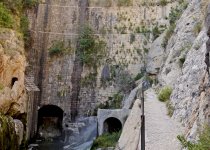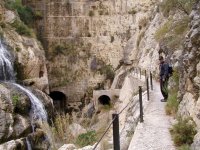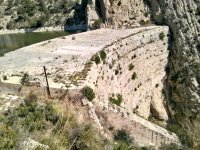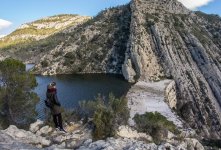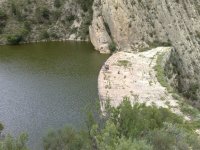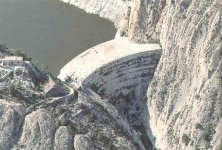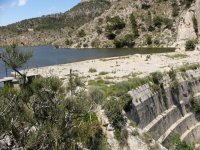Here we have another impossible, in my opinion, 16th century achievement. This time it is one of the oldest known dams. The Tibi Dam was built in Spain between 1579 and 1594. Before I go into the description of the dam itself, I wanted to emphasize that we are being fed this non-sense about the technological Renaissance of the 16th century.
I have a long standing issue with the traditional meaning of the word "Renaissance" itself, for the French "Naissance" means birth. And if we are talking about this hypothetical "re-birth", then an obvious question to ask would be what "birth" are we "re-birthing" from? Officially we are being told that the term "Renaissance" means some cultural "advance" from the Middle Ages. I call baloney on this substitution of concepts. If "Renaissance" was an advance to something new, it would not be called "Renaissance", for there was no previous "Naissance". We all know the real meaning to the "RE-something" - recreate, reprint, replay, redo, remake, etc.

When you google-image "Renaissance" you end up with a whole bunch of paintings, like the one above. I do not know what you see in those paintings, but I see a lot of people who do not belong inside the buildings they are portrayed in. I'm being honest with my own observations, and I do not believe for a second that the depicted society could build the presented structures.

My opinion on the true meaning of the term "Renaissance" is as follows. A long time ago our civilization was technologically advanced beyond any wildest dreams of today. Then something catastrophic happened, and the world was put into those "Dark Ages". This concept is very easy to substantiate. Just imagine an event of Biblical proportions, like a Great Flood. The majority of people are dead, the infrastructure is destroyed. Peoples' individual skills are compartmentalized. So whoever survived could have been skilled in a certain area, but without certain supporting skills, those individual skills were often worthless. For example, what would a programmer, a plumber, a bank clerk, a philosophy professor, an aircraft controller do for their survival? Food stores do not exist any longer. Electricity is a forgotten legend from the past. Eventually these spread out individuals form groups for survival and food obtaining purposes. With time these groups develop a certain structure, and attempt to return what they had in the past. Obviously whatever knowledge was able to survive would be utilized to better the life of those individuals. That is where we have this "Renaissance" - an attempt to go back to what was available before.
I think our contemporary science substituted the original meaning of the term "Renaissance" to hide that technologically advanced society. Don't ask me why they would need to hide it. This is that million dollar question we all want an answer to.
Let us look at the 16th century tools and equipment we know of today. What we see is a whole bunch of primitive devices, which are totally in line with our acquired understanding of the 16th century. I will tell you more, these tools and equipment look pretty much the same for the 17th and 18th centuries. Officially that is...

Wegmann, Edward (1918). The Design and Construction of Dams. John Wiley & Sons, Incorporated,. pp. 54–55
So, what we have is this Tibi Dam, which was built some 420 years ago. The dam is still operational and doing well from what I can see. I hope everybody understands, that building a dam of this magnitude, which still stands 420 years later, requires a bit more calculations and engineering compared to, let's say, a three story brick building.
Here is an excerpt from what has to be done today to build a similar dam:
To suggest that this Tibi Dam could have been built by the known society of the 1590s is ridiculous. We can say that the dam exists, therefore it was built, all day long, but look at this society. Did they really possess the knowledge, skills and means to build this Tibi Dam? The dam whose architect is unknown, but rather is "suspected". As we are getting used to, there is an absolute ZERO proof of the construction of this structure, no documents, no nothing, just the dam itself.
KD Summary:
I have a long standing issue with the traditional meaning of the word "Renaissance" itself, for the French "Naissance" means birth. And if we are talking about this hypothetical "re-birth", then an obvious question to ask would be what "birth" are we "re-birthing" from? Officially we are being told that the term "Renaissance" means some cultural "advance" from the Middle Ages. I call baloney on this substitution of concepts. If "Renaissance" was an advance to something new, it would not be called "Renaissance", for there was no previous "Naissance". We all know the real meaning to the "RE-something" - recreate, reprint, replay, redo, remake, etc.
My opinion on the true meaning of the term "Renaissance" is as follows. A long time ago our civilization was technologically advanced beyond any wildest dreams of today. Then something catastrophic happened, and the world was put into those "Dark Ages". This concept is very easy to substantiate. Just imagine an event of Biblical proportions, like a Great Flood. The majority of people are dead, the infrastructure is destroyed. Peoples' individual skills are compartmentalized. So whoever survived could have been skilled in a certain area, but without certain supporting skills, those individual skills were often worthless. For example, what would a programmer, a plumber, a bank clerk, a philosophy professor, an aircraft controller do for their survival? Food stores do not exist any longer. Electricity is a forgotten legend from the past. Eventually these spread out individuals form groups for survival and food obtaining purposes. With time these groups develop a certain structure, and attempt to return what they had in the past. Obviously whatever knowledge was able to survive would be utilized to better the life of those individuals. That is where we have this "Renaissance" - an attempt to go back to what was available before.
I think our contemporary science substituted the original meaning of the term "Renaissance" to hide that technologically advanced society. Don't ask me why they would need to hide it. This is that million dollar question we all want an answer to.
Let us look at the 16th century tools and equipment we know of today. What we see is a whole bunch of primitive devices, which are totally in line with our acquired understanding of the 16th century. I will tell you more, these tools and equipment look pretty much the same for the 17th and 18th centuries. Officially that is...
- Annaberg miners at their work in the early 1500s. Detail from the Bergaltar (Miners' Altar) in St. Anne's Church. Painting by Hans Hesse, ca. 1521
Wegmann, Edward (1918). The Design and Construction of Dams. John Wiley & Sons, Incorporated,. pp. 54–55
- The gorge of Tibi, which is closed by this dam, is formed entirely of hard calcareous rocks, the slopes on either side standing almost perpendicular. Its width is only 30 feet at the bottom, and 190 feet at the crown of the dam.
- The river Monegre which flows through this gorge discharges on an average about 50 gallons per second.
- The length of the Alicante reservoir is 5900 feet, its capacity being about 975,000,000 gallons.
- The dam is built of rubble masonry faced with large cut stones. Its greatest height on the up-stream side is 41 metres (134.5 feet). The plan of the dam is curvilinear, the radius of the up-stream side of the crown being 107.13 metres (351.37 feet).
- The maximum pressure in the masonry is 11.28 kilos per square centimetre (11.54 tons of 2000 lbs. per square foot).
- Water is taken from the reservoir by means of a well, 0.8 metre (2.62 feet) in diameter, which is placed in the dam itself. It is parallel with the up-stream face, and at a distance of about 2 feet from it. Fifty-one pairs of openings connect the well with the reservoir; they are o.u metre (0.36 foot) wide by 0.22 metre (0.72 foot) high, and are 0.3 metre (0.98 foot) apart horizontally and 0.41 metre (1.34 feet) vertically. The first pair is 6.97 metres (22.88 feet) below the top of the dam, and the last 2 metres (6.56 feet) above the bottom. By means of this arrangement water can be taken into the well even when much sediment has been deposited in the reservoir.
- The outlet-well connects at the base of the dam with a horizontal gallery which is parallel with the up-stream face until it reaches the side of the gorge, where it is continued by a small tunnel 0.6 metre (1.97 feet) wide by 1.7 metres (5.58 feet) high. This tunnel curves so as to discharge the water parallel with the axis of the valley. The outlet-gallery is closed at the down-stream face of the dam by a bronze gate, two inches thick, giving an opening when completely raised of 1.77 feet width by 2.30 feet height. Immediately over the gate a small chamber has been cut in the rock, where the gearing for raising the gate is placed. By means of a hand-wheel and gear-wheels engaging a rack, which is attached to the gate, one man can raise or lower the latter with ease, even when the reservoir is full. To prevent incrustations which might obstruct the gate, a small stream of water is always allowed to escape there.
So, what we have is this Tibi Dam, which was built some 420 years ago. The dam is still operational and doing well from what I can see. I hope everybody understands, that building a dam of this magnitude, which still stands 420 years later, requires a bit more calculations and engineering compared to, let's say, a three story brick building.
Here is an excerpt from what has to be done today to build a similar dam:
- Building a dam is a complex, multi-step process that requires huge amounts of manpower, raw materials, and investment. Here are the basic steps to building a gravity dam – the most common type of dam that we build. Gravity dams are so named because they are held to the ground by gravity – they weigh a lot, and are typically made from concrete or stone.
- During the site investigation stage, comprehensive engineering-geological work performed included drilling of bore holes and laboratory, geomechanical and geophysical investigations.
- Engineers must de-water the river where the dam is meant to be built. This is done by diverting the river through a tunnel that runs around the intended construction zone. Tunnels like this may be lined with concrete and are usually dug out using a combination of drilling and explosives.
- Dam construction must be started when river levels are low. A small dam called a cofferdam is built upstream of the construction zone to help funnel water into the diversion tunnel. A cofferdam may be built downstream as well, but the overall goal is to keep the construction zone dry so that the main dam can be built. Pumps may be used to remove water that penetrates the cofferdam.
- Loose rock is removed from the riverbed, and a plinth must be constructed. A plinth is a concrete foundation for the dam that embeds it in the walls and floor of the riverbed/valley. This prevents water from leaking at the edges of the dam.
- Now, it’s time to build the dam to its desired height. A concave-curved downstream surface for a dam helps it absorb the constant pressure of water that it must endure. Reinforced steel is used for the surfaces of the dam itself, and an enclosure is built. The enclosure is filled with concrete to make it extremely strong and resilient against water flow.
To suggest that this Tibi Dam could have been built by the known society of the 1590s is ridiculous. We can say that the dam exists, therefore it was built, all day long, but look at this society. Did they really possess the knowledge, skills and means to build this Tibi Dam? The dam whose architect is unknown, but rather is "suspected". As we are getting used to, there is an absolute ZERO proof of the construction of this structure, no documents, no nothing, just the dam itself.
KD Summary:
- Either there is something we do not know about the true technological abilities of the 16th century, or this dam is a leftover from that pre-Renaissance civilization, the remnants of which we see all over the world.
- Wikipedia page says it all - Tibi Dam


